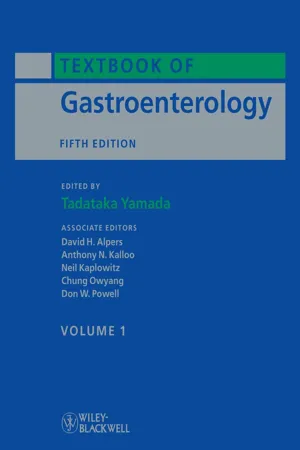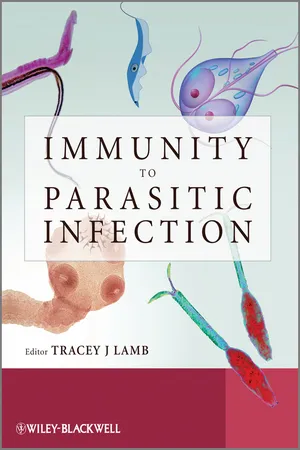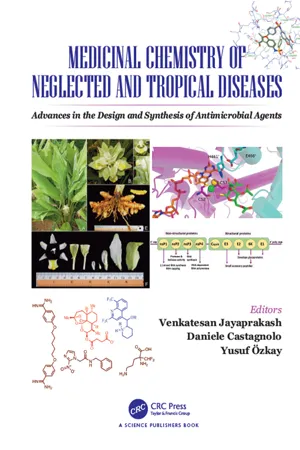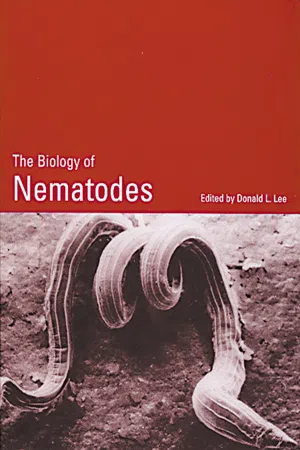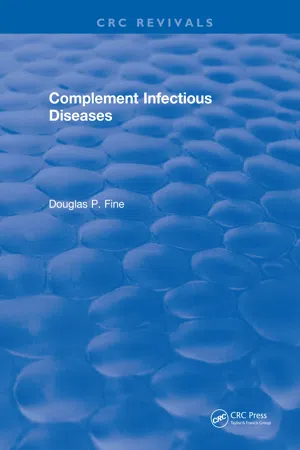Biological Sciences
Helminths
Helminths are a diverse group of parasitic worms that can infect humans and animals. They include roundworms, tapeworms, and flukes, and are typically transmitted through contaminated food, water, or soil. Helminth infections can cause a range of health issues, from mild discomfort to severe illness, and are a significant global health concern, particularly in areas with poor sanitation and hygiene.
Written by Perlego with AI-assistance
Related key terms
Related key terms
1 of 4
Related key terms
1 of 3
7 Key excerpts on "Helminths"
- eBook - ePub
- Tadataka Yamada(Author)
- 2011(Publication Date)
- Wiley-Blackwell(Publisher)
107 Parasitic diseases: Helminths Carlos Seas, Martin Montes, A. Clinton White JrIntestinal nematodes(roundworms) Trematodes (flukes) CestodesHelminth parasites, or worms, are multicellular eukaryotic organisms that are common inhabitants of the human gastrointestinal track. Throughout human history, parasitism with Helminths has been a normal part of the human condition [1–3]. Only with the development of improved standards of sanitation, housing, and food preparation in the 20th century did the prevalence of these infections decrease in wealthy countries. In contrast, the total number of infected individuals continued to increase throughout most of the 20th century. Data from the late 20th century highlighted the previously unrecognized burden of morbidity, focusing on the role of Helminths in chronic malnutrition, anemia, and accompanying cognitive defects, leading to the recognition that intestinal Helminths are neglected tropical diseases of global public health importance [4,5].Helminths are multicellular members of the animal kingdom, large enough to be visible to the human eye at some point in their life cycle. Parasites have different morphological forms that vary with the host and environment and most have an obligate one-way life cycle. In contrast to most microorganisms, Helminths do not typically reproduce within the human host. Thus, the parasite burden is largely a reflection of the infecting dose and host control of infection. Interestingly, the population structure of worm burden in communities is typically overdispersed, i.e., most of the worms live in a small portion of the population. Most of this pattern appears related to genetic predisposition [6].Helminths are categorized into three major groups: nematodes, trematodes, and cestodes. Nematodes are roundworms with a tubular gut including both a mouth and anus. There are two groups of flatworms: trematodes and cestodes. Trematodes, or flukes, are flat leaf-shaped organisms with a blind gut. All require an obligate freshwater snail host. The cestodes, or tapeworms, typically have two distinct forms. The adult forms a tapeworm in the gut of the definitive host and possesses an attachment organ (scolex) and segments (proglottids). While not having a separate gut, the external surface shares many features with the mammalian digestive tract. The proglottids are hermaphroditic, containing both ovaries and testes. The larval forms develop as cystic lesions in the tissues of the intermediate host. Some species have a second intermediate host. Many parasites use humans as an obligate host in their life cycle. In addition, related animal parasites often infect people and cause human disease. Zoonotic infections are noted with all the major nematodes groups as well as some trematodes and cestodes. The major human intestinal Helminths and their treatment are detailed in Table 107.1 - eBook - ePub
- Tracey Lamb(Author)
- 2012(Publication Date)
- Wiley-Blackwell(Publisher)
Section 3Passage contains an image 10 Introduction to Helminth Infections David B. Guiliano School of Health, Sport and Bioscience, University of East London, London, UK
The word helminth – or geohelminth – is derived from the Greek ‘helmins’ or ‘helmithos’, translating as ‘worm’; it is an umbrella term commonly used to describe a group of parasitic organisms having ‘worm-like’ anatomical characteristics. Zoologically, ‘helminth’ has come to encompass several large groups of parasitic invertebrates which we now know to be unrelated’ despite sharing some gross morphological features. These groups include the platyHelminths, nematodes, nematomorphs, acanthocephalids, and pentastomids. One of the common hallmarks of these organisms is their complex life cycles, often involving multiple hosts and highly adapted reproductive strategies.Helminths have long been recognised as causative agents of disease in humans and other animals and have shaped societal habits in many parts of the world. One example of Helminths shaping societal eating habits is the prohibition against eating pork products in several religious practices. ‘And the swine, though he divide the hoof, and be cloven footed, yet he cheweth not the cud; he is unclean to you’ (Leviticus 11: 7–8). Many believe this prohibition arose because of infections with pork tapeworm (Taeniasis, Taenia solium ; Chapter 17) and Trichinella spiralis (Trichinosis; Chapter 15), which would have been common in domesticated pigs at that time.Parasitic worms infect billions of people annually and continue to be important human pathogens. The WHO has calculated that millions of disability-adjusted life years (DALYs) are lost annually due to helminth infections. However, epidemiological studies have shown that, unlike many of the protozoal diseases, most helminth infestations are generally asymptomatic and rarely life-threatening, even in individuals harbouring heavy infections. This bespeaks either a remarkable degree of immunological trickery on the part of the parasite, or apathy by the host. Either possibility makes this a fascinating area of study for immunologists and those trying to develop vaccines to target these pathogens. - eBook - ePub
Medicinal Chemistry of Neglected and Tropical Diseases
Advances in the Design and Synthesis of Antimicrobial Agents
- Venkatesan Jayaprakash, Daniele Castagnolo, Yusuf Özkay(Authors)
- 2019(Publication Date)
- CRC Press(Publisher)
Dypylidium caninum (Romero-Benavides et al. 2017). Due to variations in their life cycles, structures, developments and resident differentiation on tissues, the diseases caused by Helminths and the applied chemotherapy may vary. Only a limited number of drugs have been approved in the last decades and is used against Helminths infections. Clinically used antihelminthic drugs are mebendazole, pyrantel, diethylcarbamazepine, ivermectin, oxamniquine, niclosamide, metrifonate and levamisole. Mostly, single or multiple dose drug administration respond to helminthiasis positively, but the currently available antihelminthic drugs are not sufficient in case of treating helminth-related systemic infections such as echinococcosis and toxocariasis (trichinosis, cysticercosis and filariasis) (Korkmaz 2012). Moreover, the development of resistance to these drugs has been reported for almost all the species of worms which infect humans in cities and also for all the species that infect animals in rural farms (Ramos et al. 2016). Thereby, studies to discover new and more effective drugs to improve physicochemical properties of clinically used antihelminthics as well as to develop treatments in combination with existing chemotheurapeutic drugs, such as antiprotozoans, anticancers and antibacterials, have been carried out, in addition to surgery or other interventions (prophylaxis). Besides, targeting helminth proteins and inhibiting their enzymes are recent focused approaches for the treatment of all kinds of worm-related diseases.Helminths
The word ‘‘Helminth” derives from the Greek word ἕλμινς (hélmins) which indicates an intestinal worm. The Helminths are invertebrates with long, flat or round bodies and their size ranges from a few millimeters to 35 centimeters. Humans are important for Helminths because they are definitive hosts in their complex life cycle (Linquist and Cross 2017, Ayi 2007).Helminths are divided into two major phyla; (1) the platyHelminths (also recognized as flatworms) which include the trematodes (also recognized as flukes) and the cestodes (also recognized as the tapeworms) and (2) the nematHelminths or nematodes (known as roundworms) which include the major intestinal worms (also recognized as soil transmitted Helminths) and the filarial worms that cause lymphatic filariasis (LF) and onchocerciasis (Rana and Misra-Bhattacharya 2013, Kim et al. 2016).Helminth parasitism remains an underestimated problem to humans in most of the developing countries. Soil transmitted Helminths like hookworm and Ascaris infect more than 24% of the world’s population, and 200 million of people are affected with schistosomiasis according to the World Health Organization. Helminths can affect humans, animals and plants, with an estimated number of between 75,000 and 300,000 species.In general, the most common parasitic infections in humans are helminthic infections. The highest prevalence happens in tropical and subtropical countries where there is poor sanitation, lack of formal education, contaminated food and lack of fresh water supply. However, some infections also occur in the developed world because of organic farming, the popularity of raw or uncooked foodstuff, and the import of diseases to northern/western countries where the diagnostic accuracy may be poor due to a lack of profound knowledge. Social, economic, genetic and nutritional factors play an important role in hookworm infections (Linquist and Cross 2017, Ayi 2007). - eBook - ePub
- Donald L Lee(Author)
- 2002(Publication Date)
- CRC Press(Publisher)
Haemonchus contortus, a parasite of sheep, goats, cattle and deer, was introduced by Stoll (1929) to describe immunity to a nematode infection (Ackert 1942), we have acquired an array of experimental and clinical host-nematode systems in which immunity occurs in the host. In this chapter we will describe immune responses characteristic of nematode infections and focus on the effector functions of immune systems, which cannot be understood separately from nematode biology. The immune responses to parasitic nematodes should bring us real insight into the biology of nematodes.Overview of Host-Parasitic Nematode Interactions
It is essential to know the basic behavioural patterns of animal-parasitic nematodes to understand the immu-nology of nematode infections. In the phylum Nematoda the parasitic mode of living has been employed several times independently (Blaxter et al., 1998). In mammalian hosts nematodes may parasitise the eye, mouth, tongue, gastrointestinal tract, liver, lungs, muscle, connective tissue, brain, lymphatics, blood or body cavity. They can be found virtually everywhere. In spite of various life cycles, which range from the very simple to the extremely complicated, and of the phylogenetic distance between groups of parasitic nematodes, it is possible to find common motifs of nematode behaviour in the nematodes of animals and humans.Principles of Parasitic Nematode Life Cycles
Infective larvae
All animal-parasitic nematodes are ‘endoparasites’, meaning parasites inside the host body. Theoretically endoparasites can be divided further into two categories. One group of parasites lives in the alimentary tract and its annex without invading the host tissue and the other enters the host body with tissue invasion. However, practically all parasitic nematodes in mammals penetrate covering epithelia of the host, namely the skin or the mucosa of the gastrointestinal tract, to enter the host body even though their final destination may be the gastrointestinal lumen. In general, parasitic nematodes enter the host when they are third-stage larvae (L3), which are thus referred to as ‘infective larvae’, and enter the vertebrate host orally or percutaneously. Oral infection takes place as the host drinks or ingests food that is either contaminated with eggs or larvae, or is parasitised by larvae. Larvae swallowed or hatched from eggs in the alimentary tract may immediately penetrate the epithelial layer to reach the mucosal tissue. Some species remain in the alimentary tract and others start extensive migrations (Figure 18.1 - Julius Kreier(Author)
- 2022(Publication Date)
- Routledge(Publisher)
immunology and Cell Biology 74 (1996)564.- 15. Wakelin, D. immunity to Parasitic infections: How Parasitic infections are Controlled. 2nd ed. Cambridge: Cambridge University Press, 1996.
- 16. Warren, K.S., ed. immunology and Molecular Biology of Parasitic infections. Oxford: Blackwell Scientific Publications, 1993.
QUESTIONS
- 1. Describe the ways in which parasitic protozoa and helminth worms evade the immune responses of their hosts.
- 2. “In parasitic infections, the disease begins with the immune response.” Discuss this statement.
- 3. Review the current status of vaccines against parasites.
- 4. Why is it important for immunologists to understand the life cycles of parasitic protozoa and helminth worms?
ANSWERS
- 1. Parasitic protozoa and Helminths are extremely versatile eukaryotes with complex life cycles. In order to survive they have evolved numerous ways to counteract hostile environmental and immunological conditions. Some parasites use their complex life cycles to minimize the possibilities of immune attack by moving from site to site, for example the malaria parasites and schistosomes, while others, such as the intestinal nematode worms actually hide by moving to the comparative safety of the alimentary tract. Toxoplasma gondii evades immune attack by migrating to the brain, an immunologically privileged site free from immune attack. Malaria parasites have the most complex life cycles of all the parasites and occupy successively the bloodstream, the liver, the bloodstream, red blood cells, the bloodstream, red blood cells and the mosquito gut. The different stages in the life cycle are antigenically distinct so the immune response is always chasing a moving target. In addition, malaria parasites exhibit a degree of antigenic diversity not seen anywhere else. Most parasites have evolved specific, and sometimes unique, ways either to avoid eliciting an immune response or escaping its consequences. Entamoeba histolytica is able to degrade IgA and to resist complement lysis and also to shed surface antigens that have been bound by antibodies. The African trypanosomes undergo antigenic variation in such a way that when one population of trypanosomes is mowed down by the immune response another population with a completely different surface coat emerges and this process is repeated indefinitely The malaria parasites and Giardia lamblia also undergo antigenic variation. Some parasites can survive in macrophages, for example the New World trypanosome Trypanosoma cruzi escapes from the phagolysosome into the host cell cytoplasm while Toxoplasma gondii prevents phagosome-lysosome fusion and multiplies in the phagosome. Sharing antigens with the host is another way to avoid recognition by the host and this method is exploited by Trypanosoma cruzi
- eBook - ePub
- Douglas P. Fine(Author)
- 2018(Publication Date)
- CRC Press(Publisher)
Chapter 6 PARASITES Primitive members of the animal kingdom, parasites may be classified as either Protozoa or Helminths (Metazoa). Discussion of those parasites or parasitic diseases for which there are data regarding the complement system will be organized around Table 1. The subject of complement activation by parasites has also been reviewed by Santoro et al. 1 Mahmoud 2 has emphasized immunologically critical differences between the Protozoa and Metazoa. Protozoa are more like bacteria, being unicellular and replicating within the host. Helminths on the other hand are multicellular and generally do not divide or multiply within the definitive host. One characteristic of parasitic infections is chronicity. It is usual for parasitic infections to last months or years and, in many cases, to be associated with relatively little in the way of symptomatic disease; even when symptomatic disease develops, destruction of the host is rarely so rapid as in bacterial and viral diseases. In many cases a fairly satisfactory symbiotic relationship develops between host and parasite. Such a situation requires that there be some circumvention of the usual host immune responses. Ogilvie and Wilson 3 divided the mechanisms by which parasites evade the immune response into two: defects in host immune response and certain characteristics of the parasites that enable them to evade an otherwise effective host response. Host immune defects might include those on a genetic or developmental basis, such as an immature immune system in the very young. Acquired host immune defects may be induced by overwhelming numbers of parasites or by soluble immunoregulatory factors secreted by parasites. Parasitic antigens may become incorporated into immune complexes, which may themselves be immunosuppressive. Many parasites go through multiple developmental stages within the host; each transformation presents an antigenically new microbe with which the immune system must cope - eBook - ePub
Parasitism and Parasitic Control in Animals
Strategies for the Developing World
- Hafiz Muhammad Rizwan, Muhammad Sohail Sajid(Authors)
- 2023(Publication Date)
- CAB International(Publisher)
1 Biology and Ecology of ParasitesHAFIZ MUHAMMAD RIZWAN1 *, SAIMA NAZ2, MOHSIN RAZA3, ASIF IQBAL4, TAHIRA IFTAKHAR5, HAIDER ABBAS1 ANDTAYYABA AKHTAR61 Department of Pathobiology, KBCMA College of Veterinary and Animal Sciences, Lahore, Pakistan; 2 Department of Zoology, University of Sindh, Jamshoro, Pakistan; 3 Department of Basic Sciences, KBCMA College of Veterinary and Animal Sciences, Narowal, UVAS, Lahore, Pakistan; 4 Department of Pathobiology, Riphah College of Veterinary Sciences, Lahore, Riphah International University, Islamabad, Pakistan; 5 Department of Parasitology, University of Agriculture, Faisalabad, Pakistan; 6 University of Veterinary and Animal Sciences, Lahore (Narowal Campus), Pakistan* Corresponding author: [email protected]© CAB International 2023. Parasitism and Parasitic Control in Animals: Strategies for the Developing World (eds H.M. Rizwan and M.S. Sajid)DOI: 10.1079/9781800621893.0001 AbstractParasites range from tiny, microscopic creatures to macroscopic species with a diverse range of classifications. They have various well-developed characteristics that make them sustainable in different habitats with several types of hosts. Parasites develop several types of relationships with their host and parasitism causes damage to the host. Protozoa have unique features and their own classification. Helminths are much more advanced than protozoa as they are multicellular. Arthropods are the most successful creatures on the planet and among them dipterans are more prevalent. Among arthropods, mosquitoes and ticks are the main external parasites that act as vectors of many pathogens. The physical and climatic features of an area help to propagate these parasitic species. Parasitic infection causes a decline in animals’ productivity and causes diseases in humans and animals. For better control of parasitic infections, we should understand the biology and ecology of parasites.
Index pages curate the most relevant extracts from our library of academic textbooks. They’ve been created using an in-house natural language model (NLM), each adding context and meaning to key research topics.
Explore more topic indexes
Explore more topic indexes
1 of 6
Explore more topic indexes
1 of 4
